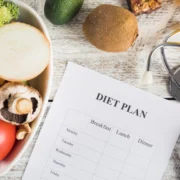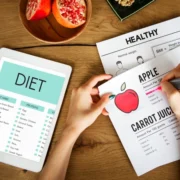Portion control is a vital aspect of healthy eating that can significantly impact our weight loss journey. By understanding the concept of portion sizes, we can better manage our meals and prevent overeating, which is essential for maintaining a healthy weight. This practice not only helps in meal planning but also encourages a balanced diet by ensuring we consume the right amounts of various food groups. Implementing effective diet tips related to portion control can lead to long-term changes in our eating habits, making it easier to stick to nutrition goals. As we delve deeper into this topic, we will explore the benefits of portion control and how to apply it in various situations, including gatherings and everyday meals.
When it comes to managing our food intake, mastering the art of serving sizes is crucial for achieving a healthier lifestyle. Often referred to as serving size management, this technique helps individuals gauge how much food they should consume to maintain energy balance and support weight management goals. By understanding the relationship between food amounts and overall health, we can cultivate better eating habits that align with our wellness objectives. This discussion will shed light on practical strategies for adjusting food quantities, particularly during social events and when preparing meals at home. Ultimately, embracing this approach not only promotes healthier choices but also enhances our overall dining experience.
Portion Sizes for Healthy Eating
When discussing healthy eating, understanding what constitutes a portion is fundamental. A portion refers to the specific amount of food that is served to an individual, and it can significantly impact our overall health. It is crucial to recognize the difference between actual serving sizes and recommended portion sizes, as many people tend to underestimate the amount they eat. Measuring portions correctly can help ensure that we maintain a balanced diet and avoid excessive calorie intake, which is essential for weight loss and healthy living.
To effectively control our portion sizes, it is helpful to use standard measurements. For instance, a standard cup measurement can help define portions for various food groups, ensuring that we consume appropriate amounts without overindulging. By becoming familiar with how much a serving should be, such as one cup of vegetables or half a cup of grains, we can better manage our dietary habits and achieve our health goals. Portion control is not just about restriction; it’s about making informed choices that support our overall well-being.
The Role of Portion Control in Weight Loss
Portion control plays a vital role in weight loss efforts by helping us regulate our energy intake. By being mindful of the portions we consume, we can prevent overeating and maintain an energy balance, which is crucial for losing weight. This approach allows individuals to enjoy a variety of foods without feeling deprived, as they can still indulge in their favorite meals while keeping their portions in check. Understanding the energy content of different foods and how to measure portions can empower individuals to make healthier choices.
Additionally, practicing portion control can lead to lasting lifestyle changes. By learning to listen to our bodies and recognizing when we are satisfied, we can develop healthier eating habits that extend beyond just weight loss. For instance, during gatherings or events, it is possible to enjoy treats while still maintaining portion awareness. This balance not only supports weight loss but also fosters a more positive relationship with food, allowing individuals to enjoy meals without guilt.
Effective Meal Planning with Portion Control
Meal planning is an effective strategy that can enhance portion control and promote healthier eating habits. By planning meals in advance, individuals can better control the ingredients and portion sizes, ensuring that they adhere to dietary guidelines and avoid excessive calorie intake. This proactive approach allows for the inclusion of a variety of food groups, promoting a balanced diet that supports weight loss and overall health.
Moreover, when meal planning, it is essential to consider the appropriate portion sizes for each food group. For example, incorporating a mix of fruits, vegetables, proteins, and whole grains in recommended portions can create satisfying meals that nourish the body. Utilizing measuring tools, such as cups and scales, during meal preparation can further reinforce portion control, making it easier to stick to healthy eating patterns throughout the week.
Managing Portions During Social Events
Navigating portion control during social events can be challenging, but it is entirely possible with the right strategies. When attending gatherings, it is essential to be mindful of portion sizes while still enjoying the experience. One effective approach is to fill half your plate with vegetables and the other half with lean proteins and whole grains, following the healthy plate model. This method not only promotes portion control but also ensures that you are consuming nutrient-dense foods.
Additionally, when faced with an array of tempting dishes, consider sampling smaller portions of several items instead of taking full servings. This allows you to indulge without overdoing it. Remember, it’s perfectly acceptable to enjoy your favorite treats in moderation. By practicing mindful eating and being conscious of portion sizes, you can enjoy social gatherings while still working towards your health and weight loss goals.
The Benefits of Accurate Portion Measurements
Accurate portion measurements are critical for maintaining a healthy diet and achieving weight loss goals. By utilizing standard measuring tools, such as cups, scales, and spoons, individuals can ensure they are consuming the appropriate amounts of food. This precision helps prevent overconsumption, which can lead to unwanted weight gain. Moreover, understanding portion sizes helps individuals make informed choices about their meals and snacks, ultimately supporting a balanced diet.
Incorporating accurate measurements into your daily routine can also introduce variety to your meals. With a better understanding of what constitutes a portion, individuals can experiment with different foods and recipes, ensuring they are not stuck in a monotonous eating pattern. This variety not only enhances the enjoyment of meals but also contributes to better nutrition by encouraging the consumption of a diverse range of nutrients.
Using Hand and Finger Measurements for Portion Control
Using hand and finger measurements can simplify the process of portion control, making it accessible for everyone. For instance, using your palm to gauge the portion of protein, such as chicken or fish, can provide a practical method for estimating serving sizes. Similarly, a handful can serve as a guide for portioning fruits or vegetables, ensuring that you consume adequate amounts without the need for complicated measuring tools.
This intuitive approach to portion sizing can be particularly beneficial in social situations or when dining out, where traditional measuring tools may not be available. By relying on your body’s natural measurements, you can easily adapt to different dining experiences while still maintaining control over your portions. This flexibility can encourage healthier eating habits in various contexts, promoting long-term success in weight management.
The Importance of Mindful Eating in Portion Control
Mindful eating is a powerful practice that complements portion control, allowing individuals to foster a healthier relationship with food. By being present during meals and paying attention to hunger and fullness cues, you can make more informed decisions about portion sizes. This awareness not only helps prevent overeating but also enhances the overall dining experience, making meals more enjoyable.
Incorporating mindfulness into your eating habits can also lead to greater satisfaction with smaller portions. When you are fully engaged with your meal, you are more likely to recognize when you are satisfied, reducing the temptation to continue eating beyond that point. Practicing mindful eating can empower individuals to take control of their portions, ultimately supporting their health and weight loss goals.
Portion Control Strategies for Busy Lifestyles
For individuals with busy lifestyles, implementing portion control strategies can be essential for maintaining healthy eating habits. Preparing meals in advance and utilizing portion-controlled containers can simplify meal management and reduce the temptation to overeat. By having ready-to-eat meals on hand that adhere to portion guidelines, busy individuals can stay on track with their diet, even on hectic days.
Additionally, choosing convenient, pre-portioned snacks can help individuals avoid unhealthy choices when hunger strikes. Opting for single-serving packs of nuts, yogurt, or fruit can assist in controlling portion sizes while still providing nutritious options. By planning ahead and making mindful choices, individuals with busy schedules can successfully navigate their dietary needs without sacrificing their health.
Understanding the Healthy Plate Model for Portion Control
The Healthy Plate Model serves as an excellent guide for understanding portion control in the context of a balanced diet. This model encourages individuals to fill half their plate with fruits and vegetables, one-quarter with lean proteins, and one-quarter with whole grains. By visualizing portion sizes through this model, individuals can easily assess their meals and ensure they are consuming a variety of nutrients essential for overall health.
Implementing the Healthy Plate Model not only supports portion control but also promotes mindful eating practices. By focusing on the composition of your meals rather than solely on calorie count, you can cultivate healthier eating habits. This approach encourages diversity in your meals, making it easier to enjoy a wide range of foods while still adhering to portion guidelines that support weight loss and maintenance.
Frequently Asked Questions
What is the importance of portion control in healthy eating?
Portion control is essential for healthy eating as it helps regulate calorie intake, which is crucial for weight loss and maintaining a healthy weight. By understanding portion sizes, individuals can make better food choices, prevent overeating, and ensure a balanced diet that aligns with the Healthy Plate Model.
How can I practice portion control with my meals?
To practice portion control, start by measuring your food using standard measurements such as cups or kitchen scales. Familiarize yourself with recommended portion sizes for different food groups, such as 1 cup of vegetables or 30 grams of cheese. Additionally, using smaller plates can help visually trick your mind into thinking you’re eating more.
What are some effective diet tips for portion control during gatherings?
During gatherings, opt for smaller portions by using a smaller plate, and fill it with a variety of foods. Prioritize healthier options like salads and vegetables, and aim to take small servings of higher-calorie items. Remember to eat slowly, allowing your body time to signal when it’s full, which is crucial for effective portion control.
What role does portion control play in weight loss?
Portion control is a key component of weight loss as it helps manage calorie intake. By controlling portion sizes, individuals can create a calorie deficit, which is necessary for weight loss. Additionally, understanding portion sizes can prevent excessive hunger and the urge to overeat, making it easier to stick to a weight loss plan.
How can I measure portions at home without scales?
You can measure portions at home using standard kitchen tools such as cups, tablespoons, and teaspoons. Familiarize yourself with visual cues like a ‘handful’ for fruits, or the size of your palm for meat portions. This method allows for practical portion control without the need for precise scales.
Is it possible to maintain weight while eating ready-made meals?
Yes, it is possible to maintain weight while eating ready-made meals by practicing portion control. Be mindful of serving sizes, and try to balance your meals by incorporating vegetables and whole grains. Adjusting your meal portions based on the calorie content of ready-made meals can help you stay on track.
What are some strategies for managing portion sizes when dining out?
When dining out, consider sharing dishes or ordering appetizers instead of full entrees. Request dressings and sauces on the side, and aim to fill half your plate with vegetables. This not only helps with portion control but also promotes healthier eating habits in a restaurant setting.
How can portion control help avoid overeating?
Portion control helps avoid overeating by establishing boundaries for how much food is consumed at one time. By understanding and adhering to recommended portion sizes, individuals can avoid the discomfort associated with overeating, such as bloating and indigestion, thereby promoting a healthier relationship with food.
What are the standard portion sizes for different food groups?
Standard portion sizes vary by food group: for example, 1 cup of cooked vegetables, ½ cup of grains like rice or pasta, and 30 grams of cheese. Understanding these standard measurements can aid in effective portion control and promote a balanced diet.
Can portion control improve my long-term eating habits?
Yes, practicing portion control can significantly improve long-term eating habits by fostering a healthier relationship with food. By learning to listen to your body and recognize hunger cues, you can develop sustainable eating patterns that support your overall health and well-being.
| Key Point | Description |
|---|---|
| What is Portion Control? | Portion control refers to the specific amount of food served to an individual, allowing them to manage their servings effectively. |
| Benefits of Portion Control | Helps maintain a healthy weight, prevents overeating, ensures dietary variety, and reduces discomfort such as bloating and indigestion. |
| Standard Measurements | Utilizing cups, hand sizes, and kitchen scales to accurately measure portions for different food groups. |
| Portion Sizes for Food Groups | Examples include: 1 cup for dairy, ¾ cup for cooked legumes, ½ cup for grains, 1 cup for cooked vegetables, and 100 grams for fruits. |
| Portion Control at Gatherings | Encourages individuals to take controlled servings at events, choosing a variety of items while adhering to portion sizes. |
Summary
Portion control is an essential aspect of healthy eating that enables individuals to manage their food intake effectively. By understanding portion sizes and employing various measurement techniques, we can maintain a balanced diet, prevent weight gain, and enjoy our meals without overindulging. With the right knowledge and practices, portion control can lead to long-term healthy eating habits, making it easier to navigate social gatherings and everyday meals.
















Comments